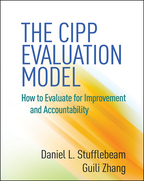The CIPP Evaluation Model
How to Evaluate for Improvement and Accountability
Daniel L. Stufflebeam and Guili Zhang
HardcoverPaperbacke-bookprint + e-book
Hardcover
orderMarch 6, 2017
ISBN 9781462529247
Price: $107.00 384 Pages
Size: 7⅜" x 9¼"
Paperback
orderMarch 7, 2017
ISBN 9781462529230
Price: $71.00384 Pages
Size: 7⅜" x 9¼"
The authoritative presentation of a leading evaluation approach, this book describes the CIPP (Context, Input, Process, and Product) Model’s origin, concepts, and procedures. Unlike many models, CIPP provides for feedback throughout a program. Richly illustrated with evaluation cases, the book covers methods for engaging stakeholders; designing, budgeting, and contracting evaluations; collecting, analyzing, and reporting information; and conducting metaevaluations. User-friendly features include 26 reproducible checklists and forms and references to relevant computer programs. Purchasers get access to a companion website where they can download and print the reproducible tools as well as supplementary materials, including the CIPP Evaluation Model Checklist.
User-Friendly Features
User-Friendly Features
- Introduction boxes providing an overview of each chapter.
- Within-chapter recaps of key concepts.
- End-of-chapter review questions and exercises.
- End-of-book glossary.
- Appendix listing hundreds of CIPP evaluations across disciplines.
“Stufflebeam is one of the great pioneers in the development of evaluation as a discipline. He developed the CIPP Model to highlight not only the outcomes of a program, but all of its dimensions: Context, Input, Process, and Product. We are fortunate to have a volume reflecting decades of refinement of this valuable tool, which has been discussed and used around the globe. Exercises, review questions, and downloadable checklists are included. The book also puts CIPP in the context of other leading models of evaluation and demonstrates its major influence upon the field.”
—Michael Scriven, DPhil, DEd, Professor of Psychologyand Co-Director, Claremont Evaluation Center, Claremont Graduate University
“Stufflebeam has been a leader in educational evaluation since the 1960s. This valuable book makes it clear why the CIPP Model has become one of the most widely used approaches to evaluation across disciplines in the social sciences. The authors distill decades of experience to provide evaluators with an approach to program improvement and accountability that engages stakeholders, meets professional standards, and encompasses both quantitative and qualitative methods. No other evaluation model has had as strong and lasting an impact as the CIPP Model, and this book offers the first comprehensive guide.”
—M. David Miller, PhD, Professor and Director, Human Development and Organizational Studies in Education; Director, Collaborative Assessment and Program Evaluation Services, University of Florida
“For over 15 years, I have used the CIPP Model as the framework for all my evaluations in health and education. It is the focus of my course in Program Evaluation. This complete CIPP resource is a 'must have' for anyone engaged in an evaluation, from planning to implementation. Each component of an evaluation is clearly laid out. I love the case studies and the coverage of topics usually overlooked in program evaluation texts, such as how to analyze quantitative results and develop an evaluation contract.”
—Mina D. Singh, RN, PhD, School of Nursing, Faculty of Health, York University, Canada
Table of Contents
1. Introduction2. The CIPP Evaluation Model: A Framework for Improvement- and Accountability-Oriented Evaluations
3. A Case Illustrating Application of the CIPP Model to Evaluate a Self-Help Housing Project 
4. Evaluation-Oriented Leadership in Launching and Supporting Effective Evaluations
5. A Second Case Illustrating Application of the CIPP Model to Evaluate a Service-Learning Project
6. Designing Evaluations
7. Budgeting Evaluations
8. Contracting Evaluations
9. Collecting Evaluative Information
10. Analyzing and Synthesizing Information
11. Reporting Evaluation Findings
12. Metaevaluation: Evaluating Evaluations
Appendix. The CIPP Model in Perspective
Glossary
About the Authors
Daniel L. Stufflebeam, PhD, was Distinguished University Professor Emeritus at Western Michigan University (WMU) until his death in 2017. He founded and directed The Evaluation Center at The Ohio State University and moved it to WMU, where he directed it until 2002. He also designed the WMU Interdisciplinary PhD Program in Evaluation. The developer of theGuili Zhang, PhD, is Professor and Interim Chair of the Department of Special Education, Foundations, and Research at East Carolina University and Guest Professor at the Institute of International and Comparative Education at Beijing Normal University in China. Dr. Zhang has presented and published extensively on evaluation. She currently serves as Chair of the Assessment in Higher Education topical interest group and the Quantitative Methods topical interest group of the American Evaluation Association. Internationally, she serves as an expert advisor to China’s Ministry of Education and the Beijing Faculty Development Center for Higher Education. Dr. Zhang is a recipient of awards including the Benjamin J. Dasher Best Paper Award from the Frontiers in Education conference, the Best Paper Award from the American Society for Engineering Education, and the Edward C. Pomeroy Award for Outstanding Contribution to Teacher Education from the American Association of Colleges for Teacher Education.
